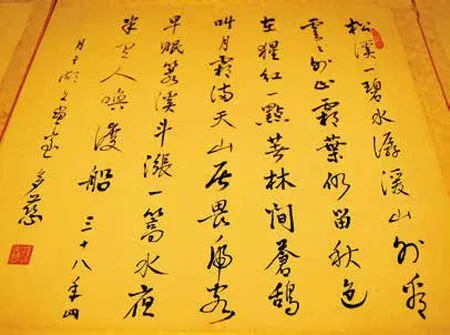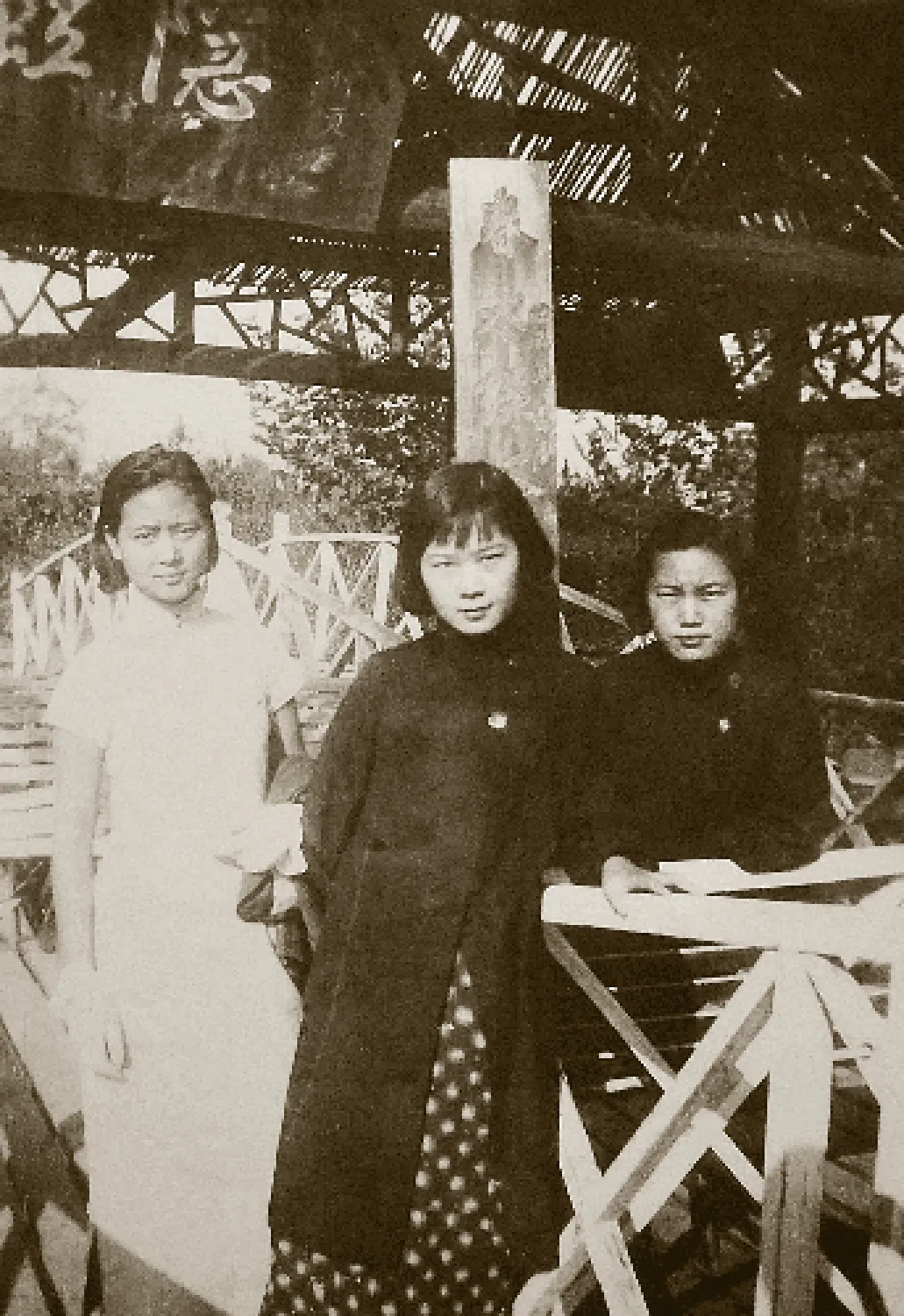画家孙多慈在孤山丽水
2016-04-13李玫梅
●李玫梅
画家孙多慈在孤山丽水
●李玫梅
在我国现当代女画家中,孙多慈是一位富有才华、在艺术上有着自己独立追求的不凡女画家。许多人对孙多慈感到陌生,即便知道一些也多是从徐悲鸿的艺术人生中获知的。那是因为孙多慈是徐悲鸿的学生,新中国成立前她去了台湾。2015年11月,浙江美术馆举办的“孤山丽水觅诗情—孙多慈画展”让许多爱好美术的人更多地了解她的艺术才情。
孙多慈又名孙韵君,出身名门望族,从小受过良好的家庭教育,1913年出生于安徽寿县。她的祖父孙家鼐是清末重臣,历任工、礼、吏、户部尚书和中国首任学务大臣,曾一手创办京师大学堂(北京大学前身)。父亲孙传瑗曾参加晚清民主革命,为一代名士。孙多慈自幼酷爱丹青,17岁时毕业于安徽省立第一中学高中部。
1930年,孙多慈到南京中央大学美术系求学。当时徐悲鸿正好是美术系主任,也时常亲自授课。因为孙多慈的冰雪聪明,加上一定的绘画天赋与其少女的清新纯真,于是,徐悲鸿先生的笔下就多了一些描绘孙多慈少女风姿的素描与油画。徐悲鸿极为欣赏孙多慈的艺术天赋,悉心传授,孙多慈也精心研习。他俩还有过一段师生间的“慈悲之恋”。徐悲鸿为她画的数幅肖像,其中《台城夜月》等两幅油画,因遭徐悲鸿妻子蒋碧微嫉妒,被取走后下落不明。
虽然绯闻被传得沸沸扬扬,但孙多慈确实是一位才女画家。离开大陆前曾在安徽、上海等地举办个人书画展,影响远播。美学大师宗白华称赞她:“天资敏悟,好学不倦,是真能以艺术为生命为灵魂者。”她的素描利落的线条和层叠光影的运用,“落笔有韵,取象不惑,好像前生与造化有约,一经睹面,即能会心于体态意趣之间……”
1935年,孙多慈毕业于中央大学。她于毕业之初就出版了个人画集。
孙多慈曾在浙江生活和工作,与浙江有着不解之缘。抗战爆发,孙多慈全家从长沙迁到桂林,又从桂林来到浙江丽水。她在浙江省立联合中学任教,仍孜孜不倦地进行美术创作。她经常去瓯江边写生,那帆影、那船工,都是她描绘的对象。
抗战时期,儿童保育会浙江分会第一儿童保育院设在丽水县碧湖镇,保育院收容来自沦陷区无家可归的难童与学生。院长是孙多慈儿时的玩伴、大学同学李家应。孙家避难到丽水,先在李家应所主持的儿童保育院暂时安顿。孙多慈在中学任教后,仍继续到保育院协助李家应照应院童的活动及生活。闲暇时她喜欢为院童速写画像,杭州画展中所选展的“保育院系列”素描作品即是其中的一部分。
那时徐悲鸿应邀去印度讲学,一去四五年不归。到1942年春回国时,孙多慈已经在父亲的安排下,认识并嫁给了时任浙江省教育厅厅长的许绍棣。

《日出》(油画) 作于1952年 Sunrise, oil painting, 1952, by Sun Duoci

书法《松溪》 1949年4月写于西湖画室Pine Stream, a calligraphic work written by Sun Duoci in April 1949 at her studio on the West Lake
从丽水来到杭州安家,孙多慈与西湖山色朝夕相伴。她的艺术生涯开始于南京中央大学,成长于浙江的丽水,发展却在她移居杭州的西子湖畔。
学习古典文学是孙多慈幼年的日常功课,渊源可溯自她的家学。孙多慈的古文造诣得自父亲。她自述:“吾父授吾以《毛诗》,曰:‘此诗也,人间之至文也;然诗也,亦画也。’授吾以《离骚》、两汉《乐府》《古诗十九首》《孔雀东南飞》诸篇什,曰:‘此辞赋与诗,人间之至文;然亦画也。’又进而授吾庄列之文,曰:‘此史也,然亦诗也、画也。汝其识之!’”
孙家在抗战时期流离迁徙,作诗填词成了家人寄情的趣事。在丽水、西湖的岁月里,吟诗作词、写生绘画是孙多慈再快乐不过的事儿。杭州画展中有一些青山绿水的风景题材作品,就是她在丽水、杭州生活的写照。
孤山丽水可视作孙多慈的第二故乡。孤山是她离开大陆前最后的居住地。她在杭州的这段时间,也是她一生中创作最旺盛的时期,杭州对孙多慈来说具有特别的意义。

孙多慈(中)与友人李家应(右)合影于杭州。Sun Duoci and her friend Li Jiaying (right) in Hangzhou
1947年后,孙多慈出国,后随丈夫转赴台湾,精研绘画,成为知名画家。上世纪五十年代又赴美国和法国进修,画艺更为圆熟。她为台湾师范大学艺术系教授并任系主任,又曾在文化大学兼任艺术系首任系主任。1948年她任台湾师范大学艺术学院教授,后任院长,教书育人,桃李满园。
“孤山丽水觅诗情—孙多慈画展”展出孙多慈作品80件,包括油画、素描、水墨、书法等,展示出她不同凡响的艺术人生。她的儿子许珏方特地从美国赶来参加画展开幕式活动。他谈到这次画展作品的来源时说:“最早这个画展是由几个学生提出来的,花了好几年时间,后来有特别的机缘找到一批画,所以才有足够的画作可以展览。”
孙多慈因患癌症,1975年2月病逝于美国洛杉矶,享年仅63岁。在孙多慈的眼中,绘画是“画心、画梦”。从丽水到杭州的这一段人生里程,是倾其生命的寻寻觅觅,构筑了她的艺术之梦。
The legend of Sun Duoci
By Li Meimei
Sun Duoci’s art attainments, known by very few, were fully displayed in Sentiments of the Solitary Hill: Sun Duoci’s Paintings, an exhibition solo held in Zhejiang Art Museum in the fall of 2015. Based in Taiwan in her later years, Anhui-born Sun Duoci (1913-1975) was a brilliant figure representing the female power in the contemporary painting art stage of China. She was also one of the favorite students of the Chinese art virtuoso Xu Beihong.
Born with a silver spoon into a dignitary family in Shouxian, Anhui Province in 1913, Sun Duoci (also known as Sun Yunjun) was the granddaughter of Sun Jianai, a high-ranking official in the late Qing government and founder of the prototype of today’s Peking University.
Sun Duoci fell in love with painting brushes at a very young age, and started her study at the Art Department of Central College in Nanjing at the age of 17. Her innocence and talent caught the eye of Xu Beihong, then the chair of the art department. Sun worked with her mentor as a model. Her Nanjing years sowed the seeds of what was later defined as the ‘love triangle’ between Sun, Xu and his jealous wife Jiang Biwei.
Despite rumors about her affair with Xu, Sun Duoci won recogni-tion from the art circle of her time fo r her outstanding talents. She was praised by aesthetics master Zong Baihua as “a hardworking, intelligent woman who takes art for life”. The year 1935 saw the release of the first art book by Sun Duoci, who was fresh from college.

孙多慈在美国讲学时挥毫示范,后立者为钢琴家吴漪曼。Sun Duoci demonstrates her calligraphy in USA. Professor and Pianist Wu Yiman looks on.

孙多慈作品《自由之歌》赠送美国总统艾森豪威尔。Ode to Freedom, a painting by Sun Duoci as a gift to USA President Dwight Eisenhower
Zhejiang was a very important part of the artist’s life. During the years of World War II, the Sun family moved from Changsha to Guilin before settling down in southwestern Zhejiang’s Lishui, where she taught in a local high school and had a good time portraying the inviting riverscape of the Ou River. In the resistance war against Japanese invaders, Bihu Town of Lishui housed the 1st Zhejiang branch of Save the Children, an organization that took orphans under its wing. The orphanage was chaired by Li Jiaying, who was a childhood friend of Sun Duoci and classmate at college. Sun Duoci spent a lot of time teaching and taking care of the refugees at the orphanage. A sketch series at the Hangzhou exhibition reflected the artist’s life in Lishui, a very special chapter of the artist’s colorful life.

《景宁风景》(油画) 作于1943年A Landscape in Jingning, oil painting in 1943 by Sun Duoci
After getting married, Sun Duoci left Lishui to start her new life in Hangzhou. For Sun, Hangzhou was a city full of wistful memories. Her stay in the city’s Solitary Hill on the West Lake was the most productive period of her artistic life. The 80 art pieces at the exhibition showed the artist’s versatility in a range of genres. The Solitary Hill was also the artist’s last home in the Chinese mainland before the Sun family moved to Taiwan in the late 1940s. In the 1950s, Sun Duoci spent several years furthering her art study and honing her painting skills in the US and France. Back in Taiwan, she joined the National Taiwan Normal University as an art professor and director of the university’s art department.
The Hangzhou debut of the artistry of Sun Duoci took Sun’s students years to get the art works ready. Her son Xu Juefang came to Hangzhou all the way from the US to introduce his mother’s artistic outlook to art enthusiasts and attended the opening ceremony. In 1975, Sun Duoci died in Los Angeles, the US at the age of 63. In the eye of Sun Duoci, the art of painting was to paint the heart and soul and to paint dreams, which she achieved beautifully in the solitude of her Hangzhou and Lishui years.
